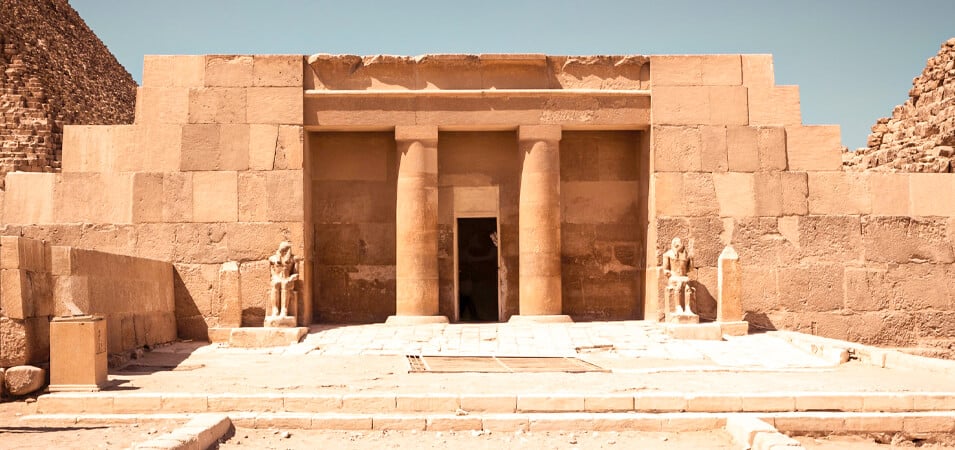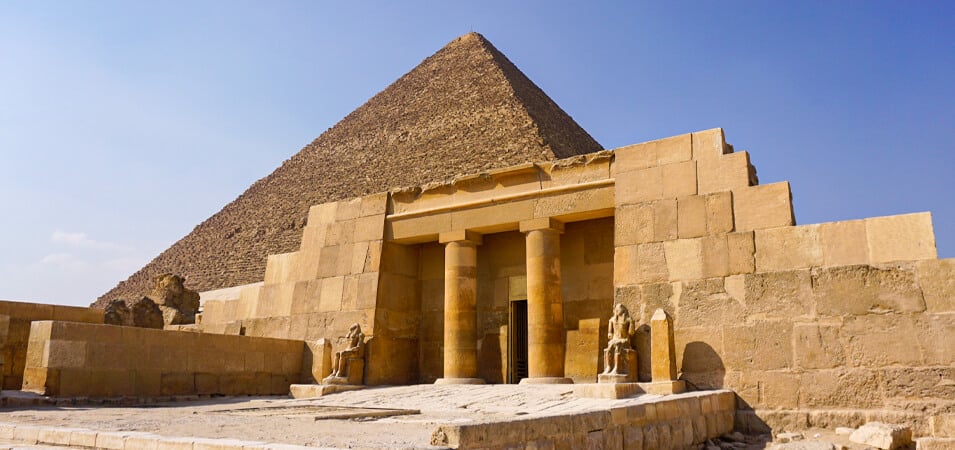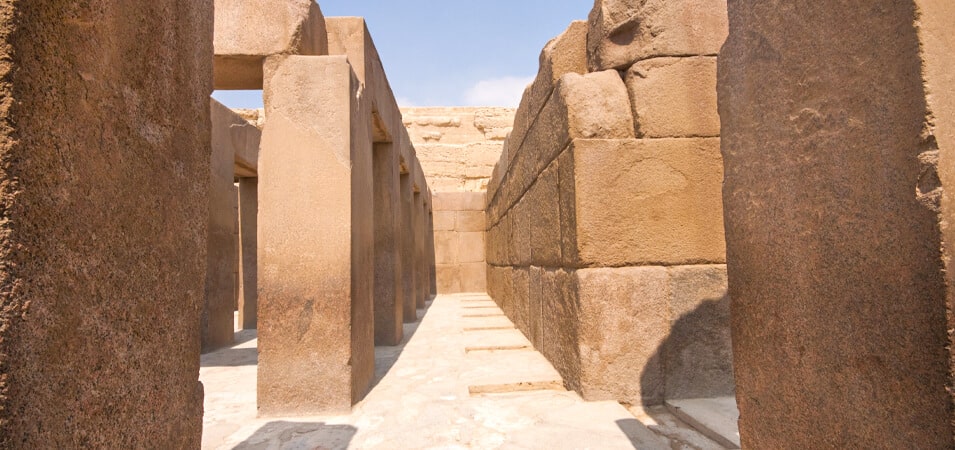In the heart of the Giza plateau, adjacent to the Great Sphinx, lies a captivating ancient structure with profound historical and cultural significance. The Valley Temple, an architectural marvel of the Old Kingdom period, is a testament to ancient Egypt’s craftsmanship and religious beliefs. With its imposing structure and enigmatic aura, the Valley Temple beckons us to explore its mysteries. Join us as we delve into this awe-inspiring temple’s history, purpose, architecture, and spiritual importance.
The Significance of the Valley Temple

The Role of the Valley Temple in Ancient Egyptian Funerary Complexes: The Valley Temple held a crucial position within the funerary complexes of the pharaohs. It served as the entrance and administrative centre for the rituals and ceremonies associated with the burial process.
Symbolic Importance and Rituals Associated with the Valley Temple: The Valley Temple represented the physical and spiritual connection between the mortal world and the realm of the gods. It was a site of purification and offerings, where rituals were conducted to ensure the deceased pharaoh’s successful journey to the afterlife.
Connection to the Afterlife and the Ka: The Valley Temple was pivotal in preserving and nourishing the deceased’s ka, the life force or soul. It provided a sanctuary where the rituals of purification, mummification, and the presentation of offerings took place.
Don’t Miss To Check Out OurEgypt Travel Packages
Architecture and Construction
Building Materials and Techniques: The Valley Temple was constructed using durable limestone blocks, carefully hewn and meticulously fitted together. The precision in craftsmanship and using high-quality materials ensured the temple’s longevity.
Layout and Design Elements: The temple featured a symmetrical layout, with a central hall leading to various chambers and passageways. Columns, statues, and intricate reliefs adorned the interior, depicting scenes of religious significance and conveying the pharaoh’s divine authority.
Structural Features and Engineering Marvels: The Valley Temple showcased advanced engineering techniques, including massive stone blocks, impressive corbelled ceilings, and an ingenious drainage system. These architectural feats showcased the mastery of ancient Egyptian builders.
Rediscovery and Restoration

Rediscovery of the Valley Temple: The Valley Temple, lost to the sands of time, was rediscovered in the early 19th century. Archaeological expeditions unearthed the hidden treasures of this ancient structure, shedding light on its historical and cultural significance.
Challenges Faced in Preservation: Preserving the Valley Temple posed significant challenges, including erosion, environmental factors, and the passage of centuries. Human intervention, natural disasters, and modern development threatened the temple’s integrity.
Restoration Efforts and Ensuring Long-Term Conservation: Dedicated teams of archaeologists, conservators, and experts have undertaken meticulous restoration efforts to protect and conserve the Valley Temple. Through careful research, documentation, and modern techniques, they strive to ensure its longevity for future generations.
Cultural Significance and Tourist Attraction
Archaeological Importance and Historical Context: The Valley Temple stands as an important archaeological site, providing valuable insights into the religious beliefs, funerary practices, and architectural achievements of ancient Egypt. Its discovery and exploration contribute to our understanding of this magnificent civilization.
Visitor Experience and Highlights of the Valley Temple: Visitors to the Valley Temple are treated to a mesmerizing journey through time. They can marvel at the grandeur of the temple’s architecture, admire intricate reliefs, and imagine the rituals and ceremonies that once took place within its sacred walls.
Contribution to Egypt’s Cultural Identity: The Valley Temple, the neighbouring pyramids, and the Great Sphinx have become an enduring symbols of Egypt’s rich cultural heritage. It serves as a testament to the remarkable achievements of ancient Egyptian civilization and continues to inspire awe and fascination worldwide.
The Valley Temple: Gateway to Ancient Egypt

Mystique and Intrigue of the Valley Temple: The Valley Temple’s enigmatic aura and connection to ancient rituals evoke a sense of wonder and curiosity. It is a gateway to a bygone era, offering a glimpse into the spiritual and cultural practices that shaped ancient Egypt.
Insights into Ancient Egyptian Religion and Funerary Practices: Exploring the Valley Temple provides valuable insights into ancient Egypt’s religious beliefs and funerary practices. It allows us to understand their complex cosmology, reverence for the afterlife, and unwavering devotion to their pharaohs.
Appreciating the Legacy of Ancient Egypt’s Architectural Marvels: The Valley Temple is a testament to ancient Egypt’s ingenuity and architectural brilliance. It reminds us of the timeless legacy left by this remarkable civilization, inspiring us to appreciate and preserve their architectural marvels for future generations.
Conclusion
The Valley Temple, nestled within the Giza plateau, stands as a doorway to the past, inviting us to explore the wonders of ancient Egypt. With its profound spiritual significance, awe-inspiring architecture, and cultural heritage, the Valley Temple is a tangible link to the bygone era. As we uncover its mysteries and appreciate its grandeur, we pay homage to the extraordinary legacy of ancient Egyptian civilization.
Don’t Miss To Read Out Our Related Article:
